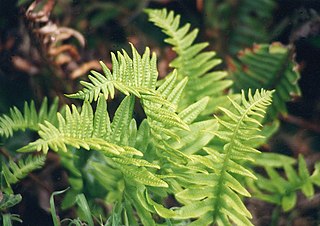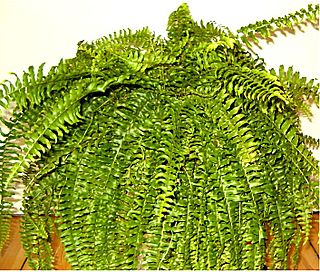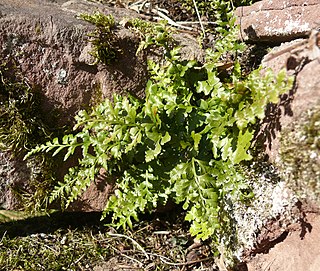
Thelypteridaceae is a family of about 900 species of ferns in the order Polypodiales. In the Pteridophyte Phylogeny Group classification of 2016, it is placed in the suborder Aspleniineae. Alternatively, the family may be submerged in a very broadly defined family Aspleniaceae as the subfamily Thelypteridoideae.

The Aspleniaceae (spleenworts) are a family of ferns, included in the order Polypodiales. The composition and classification of the family have been subject to considerable changes. In particular, there is a narrow circumscription, Aspleniaceae s.s., in which the family contains only two genera, and a very broad one, Aspleniaceae s.l., in which the family includes 10 other families kept separate in the narrow circumscription, with the Aspleniaceae s.s. being reduced to the subfamily Asplenioideae. The family has a worldwide distribution, with many species in both temperate and tropical areas. Elongated unpaired sori are an important characteristic of most members of the family.

The Dryopteridaceae are a family of leptosporangiate ferns in the order Polypodiales. They are known colloquially as the wood ferns. In the Pteridophyte Phylogeny Group classification of 2016 (PPG I), the family is placed in the suborder Polypodiineae. Alternatively, it may be treated as the subfamily Dryopteridoideae of a very broadly defined family Polypodiaceae sensu lato.

The order Polypodiales encompasses the major lineages of polypod ferns, which comprise more than 80% of today's fern species. They are found in many parts of the world including tropical, semitropical and temperate areas.

Polypodiaceae is a family of ferns. In the Pteridophyte Phylogeny Group classification of 2016, the family includes around 65 genera and an estimated 1,650 species and is placed in the order Polypodiales, suborder Polypodiineae. A broader circumscription has also been used, in which the family includes other families kept separate in PPG I. Nearly all species are epiphytes, but some are terrestrial.

Blechnaceae is a family of ferns in the order Polypodiales, with a cosmopolitan distribution. Its status as a family and the number of genera included have both varied considerably. In the Pteridophyte Phylogeny Group classification of 2016, the family has 24 genera, and excludes genera placed in the separate family Onocleaceae. The family is divided into three subfamilies, including Blechnoideae s.s. Alternatively, the entire family may be treated as the subfamily Blechnoideae s.l. of a very broadly defined family Aspleniaceae, and include genera others place in Onocleaceae.

Nephrolepis is a genus of about 30 species of ferns. It is the only genus in the family Nephrolepidaceae, placed in the suborder Aspleniineae of the order Polypodiales in the Pteridophyte Phylogeny Group classification of 2016. The genus is commonly referred to as macho ferns or Boston ferns. The fronds are long and narrow, and once-pinnate, in the case of one Bornean species reaching thirty feet in length.

The Athyriaceae are a family of terrestrial ferns in the order Polypodiales. In the Pteridophyte Phylogeny Group classification of 2016 (PPG I), the family is placed in the suborder Aspleniineae, and includes two genera. Alternatively, it may be treated as the subfamily Athyrioideae of a very broadly defined family Aspleniaceae. The family has with a cosmopolitan distribution.

Onocleaceae is a small family of terrestrial ferns in the order Polypodiales. It is placed in the suborder Aspleniineae in the Pteridophyte Phylogeny Group classification of 2016. Alternatively, the family, along with Blechnaceae, may be placed in a very broadly defined family Aspleniaceae as the subfamily Blechnoideae. The family may contain from one to four genera, consisting of five species largely in north temperate climes. The four genera, Matteuccia, Onoclea, Onocleopsis and Pentarhizidium, may be included under the single genus Onoclea.

Woodsiaceae is a family of ferns. In the Pteridophyte Phylogeny Group classification of 2016 (PPG I), it is placed in the suborder Aspleniineae. The family can also be treated as the subfamily Woodsioideae of a very broadly defined family Aspleniaceae sensu lato. In PPG I, the family contained only one genus, Woodsia. In 2020, Physematium was split off from Woodsia on the basis of molecular phylogenetic evidence. As of June 2023, Plants of the World Online continued to treat Physematium as a synonym of Woodsia.

Aspleniineae is a suborder of ferns in the order Polypodiales. It is equivalent to the clade eupolypods II in earlier systems; it is also treated as a single very broadly defined family Aspleniaceae. The suborder generally corresponds with the order Blechnales as described by J. L. Reveal in 1993. Aspleniineae includes some important ferns, including Onoclea sensibilis, the sensitive fern, which grows as a virtual weed throughout much of its temperate North American range, and ferns of the genus Thelypteris, a genus that has shown remarkable speciation. It also includes one of the more common horticultural ferns, Matteuccia struthiopteris, the ostrich fern.

Diplazium is a genus of ferns that specifically includes the approximately 400 known species of twinsorus ferns. The Greek root is diplazein meaning double: the indusia in this genus lie on both sides of the vein. These ferns were earlier considered part of either the Athyriaceae, Dryopteridaceae, Aspleniaceae, or Polypodiaceae families or recognized as belonging to their own taxonomic family. The Pteridophyte Phylogeny Group classification of 2016 places the genus in the Athyriaceae. The taxonomy of the genus is difficult and poorly known, and by 2009 has never been the subject of a complete monographic study. Their distribution is pantropical, with a few species extending into temperate areas.

Homalosorus is a genus of fern with only one species, Homalosorus pycnocarpos. It may also be referred to by its older synonyms Athyrium pycnocarpon and Diplazium pycnocarpon. Commonly referred to as the narrow-leaved glade fern, narrow-leaved-spleenwort, or glade fern, it is endemic to eastern North America and typically grows in moist woodlands. Once classified in the family Athyriaceae due to its linear, often doubled sori, in the Pteridophyte Phylogeny Group classification of 2016, it is placed in the small family Diplaziopsidaceae, whose other three species are native to east Asia. Other sources place the genus in the subfamily Diplaziopsidoideae of a very broadly defined family Aspleniaceae, equivalent to the suborder Aspleniineae in PPG I.

Cystopteridaceae is a family of ferns in the order Polypodiales. In the Pteridophyte Phylogeny Group classification of 2016 (PPG I), the family is placed in the suborder Aspleniineae of the order Polypodiales, and includes three genera. Alternatively, it may be treated as the subfamily Cystopteridoideae of a very broadly defined family Aspleniaceae.

Hypodematiaceae is a family of ferns in the order Polypodiales. In the Pteridophyte Phylogeny Group classification of 2016 (PPG I), the family is placed in the suborder Polypodiineae. Alternatively, it may be treated as the subfamily Hypodematioideae of a very broadly defined family Polypodiaceae sensu lato. The family consists of two, or in some versions three, small genera.
Hemidictyum is a genus of ferns with a single species, Hemidictyum marginatum, commonly known as the marginated half net fern. In the Pteridophyte Phylogeny Group classification of 2016, it is the only genus in the family Hemidictyaceae. Alternatively, the family, along with Aspleniaceae sensu stricto, may be placed in a much more broadly defined family Aspleniaceae as the subfamily Asplenioideae.

Diplaziopsidaceae is a family of ferns in the order Polypodiales. In the Pteridophyte Phylogeny Group classification of 2016 (PPG I), the family is placed in the suborder Aspleniineae, and includes two genera. Alternatively, it may be treated as the subfamily Diplaziopsidoideae of a very broadly defined family Aspleniaceae.
Rhachidosorus is a genus of ferns in the order Polypodiales. It is the only genus in the family Rhachidosoraceae in the Pteridophyte Phylogeny Group classification of 2016. Alternatively, the genus may be placed in the subfamily Rhachidosoroideae of a more broadly defined family Aspleniaceae, the family placement used in Plants of the World Online as of November 2019.
The Pteridophyte Phylogeny Group, or PPG, is an informal international group of systematic botanists who collaborate to establish a consensus on the classification of pteridophytes that reflects knowledge about plant relationships discovered through phylogenetic studies. In 2016, the group published a classification for extant pteridophytes, termed "PPG I". The paper had 94 authors.

Parapolystichum is a genus of ferns in the family Dryopteridaceae, subfamily Elaphoglossoideae, in the Pteridophyte Phylogeny Group classification of 2016. The genus is mainly native to the tropics, although its range extends to southeastern Australia.
















